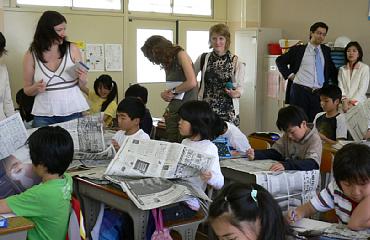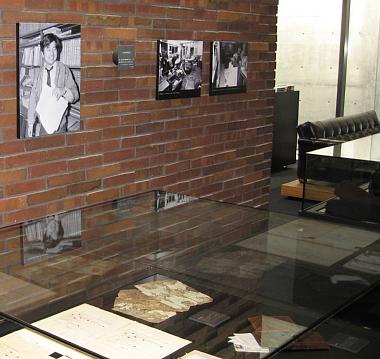|
The registration form
NSK News Bulletin Online
June 2006 -------------------------------------------------------------------
*Topics --Memorial to Slain Reporter Re-Opens at New Asahi Hanshin Branch - - - - - - - - - - - - - - - - - - - - - - - - - - - - - - - - - - - - - - Story of the Month>>> Cross-Media Advertising: Ad Agencies Focus on Newspaper-Web Synergies ------------------------------------------------------------------- Kyodo News updated guidelines for reporters Kyodo News on April 1 issued updated guidelines for its reporters, based on its editorial mission statement. The guidelines were drafted in the aim producing a document that helps reporters to actively perform their role. They reconfirm the raison d°«etre of Kyodo News amid changes in the media environment. The new guidelines comprise a preamble and six clauses, including sections titled °»Basic Stance°… and °»Human Rights and Privacy.°… They are to be distributed to all employees in leaflet form. The preamble cites the °»pursuit of facts,°… °»scrutiny of authority,°… °»protection of human rights°… and °»maintenance of freedom and independence°… as the company's goals and says Kyodo News must maintain public trust through a °»sincere and modest posture,°… as well as a °»high level of professional awareness.°… The °»Basic Stance°… clause says Kyodo delivers news °»accurately and swiftly°… as its fundamental function, while striving to provide °»in-depth and easy-to-understand°… coverage to meet the requirements of the multi-media era. It urges reporters never to forget the °»weight of facts°… and to make their utmost efforts to "get the story". The °»Human Rights and Privacy°… clause reaffirms the principle of °»reporting using real names°… but says anonymity can be maintained, depending on the circumstances. It emphasizes that consideration must be given to victims of crime or accidents out of respect for their human rights and privacy. It also tells journalists that they must avoid overly aggressive pack reporting, called the °»media scrum°… in Japan, and should use diverse methods in newsgathering. The °»Attribution of Information and Non-Disclosure of News Sources°… clause says information should be attributed to the source(s) but only °»to the extent possible.°… It also defines the protection of confidential news sources °»as one of a reporter's most serious obligations.°… Kyodo officials say that new rules adopted last year by top U.S. media on the use of information from anonymous sources were used as a reference for Kyodo°«s guidelines. The °»Newsgathering Methods and Treatment of Information°… clause contains a new rule on using the Internet for newsgathering. It says reporters should not directly quote information from the Internet, except for certain reliable information available from Web sites operated by public organizations. The °»Professional Ethics°… clause urges reporters to keep an appropriate distance from the objects of their newsgathering, citing a list of things to be avoided. The °»Accountability°… clause emphasizes the need to respond in good faith to complaints and inquiries. A Kyodo official in charge of the new guidelines said that it is important for frontline editors and reporters to instill a soul in the written word. The official said that the real thrill of journalism is to learn what is going on earlier than the general public and to spread the word as widely as possible. He said the new guidelines aim to share the joy of journalism among all Kyodo reporters. Kyodo News is continuing with reforms to its editorial policies by reexamining its overall operations and organizational setup.
Five European Journalists Participate in Resumed Fellowship Program NSK has resumed the fellowship program with a European partner organization. A total of five journalists including a staff member of the counterpart, the European Journalism Center (EJC), visited Japan for a study tour in May. The journalists°« exchange program was initially conducted with Journalists in Europe (JE), then based in Paris. As that organization ceased operations at the end of 2002, NSK has made a fresh start with a new partner, EJC, an independent, international, nonprofit institute based in Maastricht, the Netherlands, dedicated to the highest standards in journalism, primarily through the further training of journalists and media professionals. Both last year and this year, a Japanese journalist completed a three-month internship with the EJC, and at present another Japanese journalist is pursuing his internship in Brussels. Last month°«s program was the first opportunity for NSK to invite European journalists to Japan since the fellowship was resumed. The fellows devoted themselves fully to the 13-day schedule in Japan, which included briefings in Tokyo on such dimensions as politics, culture and the economy, as well as a local observation tour to Hiroshima and Kyoto. They flew home on May 27. At the welcome reception, held on May 16 at the National Press Club, Mr. Toshihiko UJI, managing director of the Chunichi Shimbun, delivered a welcome speech as chairman of the international affairs committee of NSK. Although he admitted that the spread of the Internet allows people to obtain information on a distant country more easily, he reminded audience members that a firsthand experience with a different culture remains invaluable?and indispensable for journalists to understand foreign affairs. Ms. Sanita JEMBERGA, European correspondent for the Diena newspaper in Latvia, told that her image of Japan had been merely of samurai and sushi, adding that she wanted to learn about contemporary Japan, people's lifestyles and the social status of Japanese women. The European journalists visited an elementary school in Tokyo on May 22 to observe Japanese education firsthand. They ate a school lunch, attended Newspaper in Education (NIE) classes for fourth- and fifth-graders(photo), and talked with the principal and some pupils. Mr. Sebastien FALLETTI, journalist with the Europolitique of Belgium, said he had taught history for three years at a senior high school in his native France. He said that the day after the September 11 attacks on the United States, he had his students read all the French newspapers in class in a comparative study of how each paper reported the incident and from what perspective. He said he wanted each student to develop his or her own views and added that newspapers are a good starting point for such studies. He observed an NIE class in which fifth-graders clipped articles of interest from newspapers and wrote new headlines. He said the students took the initiative and had fun, noting that Japanese students usually tend to be passive players in educational activities. Some students showed their interest in foreign events with questions for Ms. Barbara SCHMIDT-MATTERN, Deutschlandfunk Editor/Presenter. With Germany about to host the 2006 FIFA World Cup, students quizzed Ms. Schmidt-Mattern about soccer and German cuisine.
|
||||||||||||||

